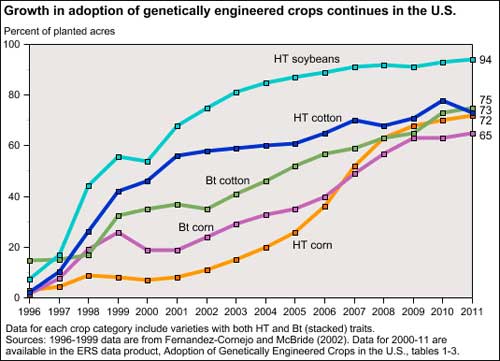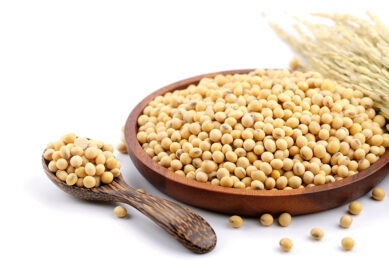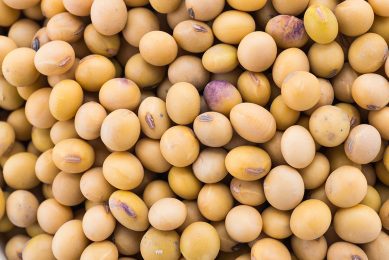GM-soybeans have become regular in US

Since 94% of all soybeans in the US are GM these varieties now have become the ‘regular’ crop. Also the majority of cotton and corn crops are genetically modified, as USDA statistics show.
US farmers have adopted genetically engineered (GE) crops widely since their commercial introduction in 1996, notwithstanding uncertainty about consumer acceptance and economic and environmental impacts.
In terms of share of planted acres, soybeans and cotton have been the most widely adopted GE crops in the US, followed by corn.
USDA’s National Agricultural Statistics Service (NASS) provide the data in the June Agricultural Survey annually for 2000 through 2011 in the following tables (follow links below).
Randomly selected farmers across the United States were asked if they planted corn, soybeans, or upland cotton seed that, through biotechnology, is resistant to herbicides, insects, or both.
Conventionally bred herbicide-tolerant varieties were excluded. "Stacked" gene varieties are those containing GE traits for both herbicide tolerance (HT) and insect resistance (Bt).
According to NASS, the States published in these tables represent 81-86% of all corn planted acres, 87-90% of all soybean planted acres, and 81-93% of all upland cotton planted acres (depending on the year).
Use increase
Use of Bt corn will likely continue to fluctuate over time, based on expected infestation levels of European corn borer (ECB), and the corn rootworm which are the main pests targeted by the Bt corn.
Similarly, adoption of Bt cotton depends on the expected infestation of Bt target pests, such as the tobacco budworm, the bollworm, and the pink bollworm.
Adoption appears to have reached the low-growth phase, as adoption has already occurred on acreage where Bt protection is needed most.
Insects have not posed major problems for soybeans, so insect-resistant varieties have not been developed.
The figure below includes adoption of "stacked" varieties of cotton and corn, which have both HT and Bt traits.
Adoption of stacked varieties has accelerated in recent years. Stacked cotton reached 58% of cotton plantings in 2011. Plantings of stacked corn made up 49% of corn acres in 2011.
Adoption of all GE cotton, taking into account the acreage with either or both HT and Bt traits, reached 90% in 2011, versus 94% for soybeans (soybeans have only HT varieties). Adoption of all biotech corn was 88% in 2011.
These tables will be updated with 2011 GE adoption figures in July 2012 once the survey data become available at the end of June 2012.
Global acreage
Many people are interested in information about the global GE acreage. USDA does not collect these data. Estimates are produced by the International Service for the Acquisition of Agri-biotech Applications (ISAAA) and can be found in the report, Global Status of Commercialized Transgenic Crops: 2010.
Many people are interested in information about the global GE acreage. USDA does not collect these data. Estimates are produced by the International Service for the Acquisition of Agri-biotech Applications (ISAAA) and can be found in the report, Global Status of Commercialized Transgenic Crops: 2010.











